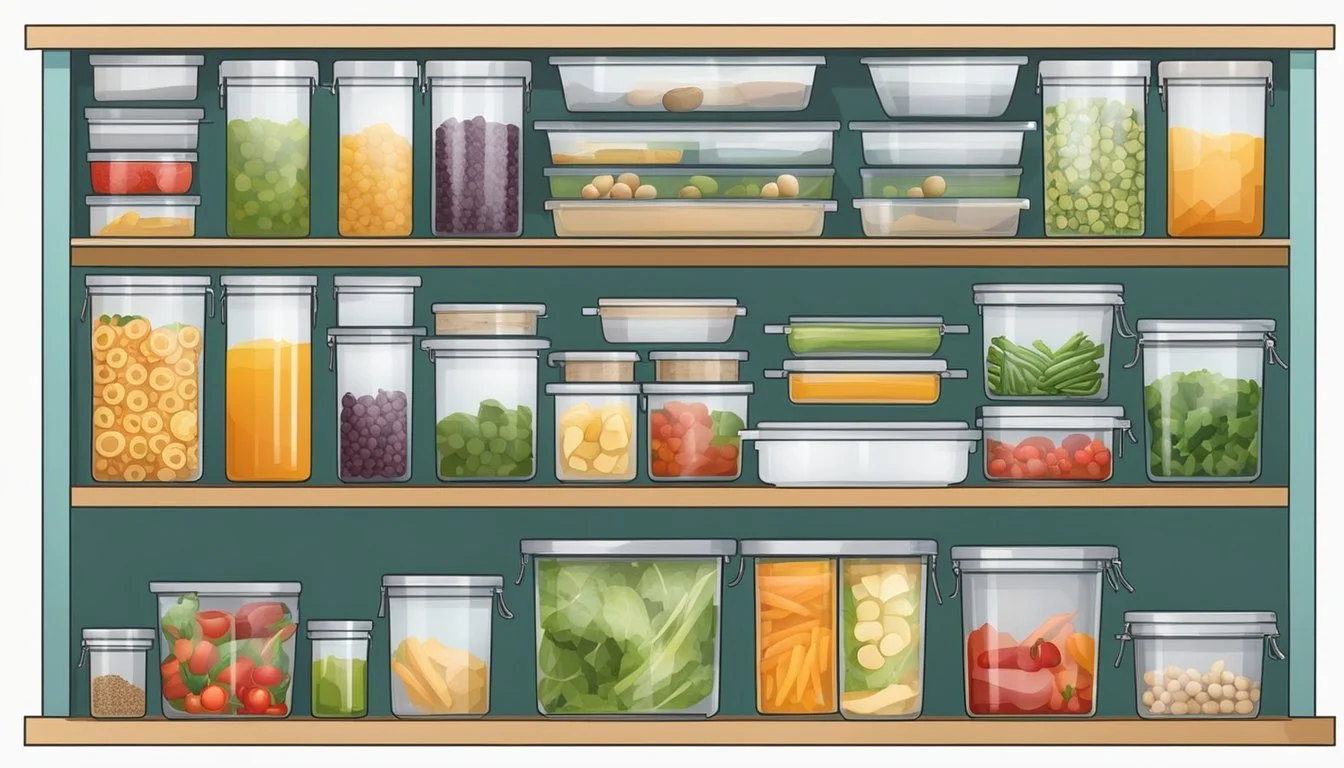Organizing Your Kitchen for an Elimination Diet
Streamlined Strategies for Dietary Success
Embarking on an elimination diet requires thoughtful preparation, particularly when it comes to organizing one's kitchen. This dietary approach involves removing certain foods that are common allergens or irritants for a period, often to identify adverse food reactions or sensitivities. Essential to the success of this diet is a well-structured kitchen environment that minimizes the risk of consuming excluded items and simplifies the process of meal preparation.
Organization strategies become pivotal during the preparatory phase. This includes identifying and segregating trigger foods such as gluten, dairy, eggs, soy, and nuts. It's important to allocate specific areas in the pantry, fridge, and freezer for allowed food items. Additionally, planning meals ahead and ensuring the availability of appropriate recipes and substitutions can help maintain a balanced diet while on the elimination protocol.
To sustain an elimination diet, the kitchen must transform into a supportive space that encourages adherence to the diet's guidelines. Clear labeling of food storage containers and keeping a list of 'safe' foods visible can aid in avoiding accidental ingestion of excluded items. The goal is to create a kitchen where meal preparation is streamlined, reducing the chance that dietary restrictions will lead to mealtime stress or nutritional imbalances.
Understanding Elimination Diets
An elimination diet involves removing specific foods or ingredients from one's diet that are suspected of causing allergies, sensitivities, or intolerances. The primary goal is to identify trigger foods that contribute to symptoms and inflammation, enabling individuals to adapt their eating habits for better health.
Key Elements of an Elimination Diet:
Identification: They typically begin by eliminating common allergens and foods known to cause discomfort.
Duration: The process usually spans a few weeks to a couple of months.
Reintroduction: Foods are then gradually reintroduced, monitoring for symptoms to pinpoint the culprits.
During an elimination diet, participants should meticulously track their food intake and any changes in symptoms. This meticulous approach can help identify which foods cause adverse reactions.
Professionals Involved:
A doctor or registered dietitian should guide this type of diet to ensure nutritional needs are met and to avoid unnecessary restrictions.
Recognizing Symptoms:
Symptoms linked to food allergies, intolerances, or sensitivities can vary. They might include:
Digestive issues
Skin irritations
Respiratory problems
Chronic fatigue
To conduct an elimination diet effectively:
Prepare: Organize the kitchen by removing potential trigger foods and stocking up on safe alternatives.
Plan: Create a meal plan that adheres strictly to the elimination guidelines.
Document: Keep a detailed food diary to note what was eaten and any symptoms experienced.
By following these steps, an individual may discover specific dietary triggers that once identified, can help in managing or alleviating their health concerns.
Common Allergens and Intolerances
When tailoring a kitchen for an elimination diet, understanding which foods are common allergens and intolerances is vital. This understanding helps minimize the risk of reactions and ensures accurate identification of sensitivities.
Dairy Products
Lactose Intolerance: A prevalent condition where dairy products, including milk, cheese, and yogurt, can cause symptoms due to the lack of the enzyme lactase.
Gluten-Containing Grains
Celiac Disease and Gluten Sensitivity: Grains like wheat, rye, and barley contain gluten, which can induce reactions in some individuals. Choosing gluten-free alternatives is essential.
Nightshades and Other Vegetables
Nightshades: Vegetables such as tomatoes and peppers may provoke symptoms in sensitive individuals.
Corn and Soy: Common in many processed foods, can cause adverse reactions and are often excluded in elimination diets.
Fruits and Sweeteners
Citrus Fruits: Sometimes linked to food intolerances, requiring temporary removal.
Natural Sweeteners: Items like honey and maple syrup are often eliminated due to sugar content.
Legumes and Nuts
Peanuts and Tree Nuts: Common allergens requiring caution; they can also include seeds.
Legumes: Include foods such as beans and lentils, which can cause sensitivities.
Meats and Seafood
Eggs and Fish: Common intolerances, occasionally extended to all types of meat including pork.
Shellfish: (What wine goes well with shellfish?) Highly allergenic, often removed from diets when testing for allergies.
Fats and Oils
Common Cooking Oils: Including olive oil, coconut oil, and avocado oil are generally well-tolerated, but sometimes excluded to test for sensitivities.
Condiments and Spices
Salt and Spices: Some diets eliminate all spices, while specific ones like paprika and cayenne pepper are removed due to nightshade content.
Beverages
Alcohol and Caffeine: Often eliminated to rule out reactions; this includes apple cider and beverages containing coconut milk.
Planning Your Kitchen Layout
When embarking on an elimination diet, the organization of one's kitchen plays a pivotal role. Strategic layout planning enables efficient meal preparation and ensures that safe foods are easily accessible while potential trigger foods are kept out of immediate reach.
Setting Up Kitchen Zones
The concept of kitchen zones streamlines meal planning and preparation, especially crucial for an elimination diet. A kitchen should be divided into specific areas for cooking, preparation, storage, and a cleaning zone. Within the cooking zone, prioritize accessibility to frequently used equipment and ingredients such as coconut milk or other non-dairy alternatives. The preparation area should have ample cutting space and be equipped with resources to handle a variety of food groups. Each zone should be set up based on the frequency of use and the importance of avoiding cross-contamination with trigger foods.
Labeling and Storage Solutions
Proper labeling and storage are essential for avoiding accidental consumption of trigger foods. Storage solutions should include:
Transparent containers: Allows for easy identification of contents.
Airtight sealing: Preserves freshness and prevents contamination.
Color-coded labels: Designate specific colors for safe food groups and another for those being eliminated.
Here's an example of how one might structure labels:
Food Group Label Color Notes Vegetables Green Always Safe Fruits Blue Safe (except triggers) Grains Yellow Elimination Phase Dairy & Alternates Red Strictly Avoid
For effective use of space, one could utilize vertical storage solutions and tiered shelving to group safe foods together. Implementing a food journal in the storage zone can help track symptoms and reactions, providing valuable insights for one's meal plan. Lastly, having a designated area for recipes that adhere to the diet simplifies meal preparation and helps maintain a routine free from processed foods and common allergens.
Shopping and Food Preparation
When embarking on an elimination diet, individuals need to meticulously plan their shopping and food preparation to ensure compliance and to ease the avoidance of triggers for food sensitivities or intolerances. Proper organization can aid in managing symptoms for conditions such as IBS and can make the diet more manageable and less daunting.
Creating a Shopping List
A well-structured shopping list is pivotal for a successful elimination diet. One should start by examining their meal plan and recipes for the week, listing ingredients for each meal while ensuring that none are known irritants. A sample shopping list could look like this:
Proteins: Skinless chicken breast, wild-caught fish
Grains: Quinoa, brown rice, millet
Vegetables: Broccoli, carrots, cauliflower (if not sensitive)
Fruits: Blueberries, oranges, apples
Dairy alternatives: Almond milk, coconut yogurt
Pantry staples: Olive oil, garlic, herbs and spices (excluding triggers)
It is crucial to check labels for hidden ingredients that could provoke food intolerances.
Meal Prepping Strategies
For meal preparation, individuals should allocate a set time for cooking to streamline their diet and reduce the risk of accidental consumption of trigger foods. Here's an effective strategy:
Batch cook grains: Quinoa and rice can be cooked in large quantities and stored in the fridge for up to a week or in the freezer for longer periods.
Chop and store vegetables: Wash, chop, and store vegetables like cauliflower in air-tight containers for quick assembly of meals during the week.
Prepare protein: Cook and portion out proteins to be reheated throughout the week, ensuring each meal adheres to the elimination diet’s guidelines.
Simple recipes: Stick to simple recipes with minimal ingredients to reduce preparation time and complexity while keeping track of food intake.
By having meals planned and ingredients prepped in advance, individuals can more easily adhere to their elimination diet and identify foods that contribute to adverse reactions.
Implementing the Elimination Phase
The elimination phase is a critical step in identifying which foods may lead to unwanted symptoms such as headaches or rashes. By methodically removing and then reintroducing potential trigger foods, individuals can pinpoint the culprits and maintain a nutritionally balanced diet.
Identifying Trigger Foods
The first step in the elimination phase is to identify and remove potential trigger foods from the diet. Individuals should start by eliminating common irritants which may include:
Dairy products
Eggs
Nuts and seeds
Shellfish
Soy
It's important to meticulously document all food intake and any symptoms in a food journal. This can provide insights about the relationship between the reintroduced foods and any physical reactions.
Managing Nutritional Balance
While avoiding trigger foods, maintaining a nutritional balance is key. Individuals should focus on:
Whole foods: such as fresh fruits and vegetables
Lean proteins: to maintain muscle health
Healthy fats: including avocados, olive oil, and certain fish for essential fatty acids
They may consult with a registered dietitian to ensure that all necessary nutrients are adequately consumed during the elimination phase. Benefits of this careful approach include improved overall well-being and a more targeted, personalized diet.
Symptom Monitoring and Tracking
Effective symptom monitoring is crucial in an elimination diet, as it helps one correlate the intake of specific foods with the occurrence of symptoms. Precise tracking allows individuals to identify food triggers and adjust their diets accordingly, often leading to relief from discomforting symptoms.
Using a Food Diary
A food diary is an essential tool for individuals on an elimination diet. It should meticulously record everything consumed, including:
Food and beverage intake: List all items, their quantities, and the time they were consumed.
Symptoms: Note any physical reactions following meal consumption.
For instance, individuals could experience symptoms like bloating, stomach pain, gas, or diarrhea. It's crucial to detail the timing and severity of these symptoms in relation to food intake, which can suggest a connection to specific dietary triggers.
Noting Physical and Emotional Changes
Alongside tracking dietary intake, individuals should monitor a wide range of physical and emotional symptoms. Physical symptoms might include:
Inflammatory bowel disease manifestations: Stomach pain, bloating, gas.
Allergic reactions: Eczema, hives.
Neurological symptoms: Headaches, migraines, brain fog.
General malaise: Fatigue, lethargy.
Emotional well-being is also a key part of symptom tracking. Changes in mood or stress levels can be both a cause and an effect of dietary issues. It is important to track one’s emotional state to paint a full picture of health and to better understand the body’s reaction to the elimination diet.
Navigating the Reintroduction Phase
The reintroduction phase is critical in identifying trigger foods that may cause symptoms or gastrointestinal distress. Patients must approach this phase methodically to determine which foods contribute to food sensitivities or adverse reactions from the immune system.
Reintroducing Foods One at a Time
Sequential Introduction:
Each food group should be reintroduced individually, spaced out over several days, to isolate the effects of each type of food. For instance:
Day 1: Introduce a single serving of dairy.
Wait 72 hours before introducing the next food group.
Incremental Portions:
Begin with a small amount and gradually increase the portion if no symptoms appear. A typical schedule might look like this:
First intake: 1 teaspoon of the reintroduced food, observe for 15 minutes.
Second intake: Increase to a full tablespoon, wait for two to three hours.
Final intake: If no reaction, consume a regular serving size, and monitor symptoms for the next 3-7 days.
Monitoring Responses to Reintroduced Foods
Symptom Tracking:
Patients should closely monitor and document any signs of gastrointestinal distress or other symptoms after reintroduction:
Immediate Reactions: Note any immediate adverse responses such as itching, bloating, or stomach pain.
Delayed Reactions: Log any delayed symptoms that may occur within a few hours to days after consumption.
Reaction Assessment:
Careful assessment helps to pinpoint specific food sensitivities:
Negative Response: If symptoms occur, the last reintroduced item is likely a trigger food.
Neutral Response: If no symptoms are noted, the tested food can generally be considered safe and added back into the diet.
The diligent observation of the immune system and gastrointestinal responses during the reintroduction phase helps to craft a personalized diet that minimizes food sensitivities.
Maintaining Long-Term Dietary Health
Adhering to an elimination diet can lead to sustainable dietary health, yet it requires a conscientious approach to adapt and potentially involve professional insight for proper management.
Adapting to Dietary Changes
Individuals embarking on an elimination diet often need to make significant lifestyle changes to accommodate new eating patterns. It's crucial to be methodical:
Identify trigger foods: Pinpoint and avoid foods that cause gastrointestinal distress or other adverse reactions.
Incorporate substitutes: Replace eliminated foods like nightshade vegetables with nutrient-dense alternatives to maintain a balanced diet.
Choose diets suited to specific health needs, such as AIP (Autoimmune Protocol) for auto-inflammatory conditions or a low-FODMAP diet for IBS management.
Seeking Professional Guidance
Maintaining long-term health requires more than temporary fixes. Regular consultations with a registered dietitian can provide personalized advice tailored to one's health status and dietary goals.
A dietitian can build a customized anti-inflammatory diet plan.
For those with complex health conditions, working alongside a doctor is essential to monitor health and adjust the diet as needed.
Following these structured steps ensures that dietary adjustments not only address immediate concerns but also contribute to a healthier and more balanced lifestyle in the long run.
Desserts and Sweets Alternatives
When someone is on an elimination diet, finding suitable alternatives for desserts and sweets can become somewhat of a puzzle. However, there are several options they can turn to that satisfy cravings without compromising their dietary restrictions.
Natural Sugars: For a sweet treat, individuals should rely on natural sugars found in fruits. A fruit salad or baked apples with cinnamon can be both satisfying and nutritious. It's important to remember that moderation is key, as fruits still contain sugar.
Chickpea-Based Desserts: Chickpeas can serve as a base for sweeter options, offering a good source of protein and fiber. Blended with dates, vanilla, and a pinch of salt, they can be transformed into a smooth batter for baking. Add dark chocolate chunks for extra richness.
Low FODMAP Options: On a low FODMAP diet? Maple syrup can be a suitable sweetener instead of honey or agave. Small quantities of almond flour can be incorporated into baked goods for those who can tolerate it.
Dairy Substitutes: Ricotta made from almonds or cashews can replace traditional cheese in recipes like lemon ricotta pound cake, which pairs beautifully with fresh blueberries for added flavor and antioxidants.
Healthy Fats: Almond butter and coconut oil are excellent alternatives to include in desserts for their healthy fats and satisfying taste. Freezing almond butter with a sprinkle of sea salt can make a delicious fudge treat.
By exploring these options, individuals can continue to enjoy dessert without straying from an elimination diet. Remember, choosing whole, unprocessed ingredients will lead to the healthiest and most satisfying dessert alternatives.
Supplemental Resources and Support
When undertaking an elimination diet, individuals often benefit from a variety of resources and support systems to manage conditions such as food allergies, irritable bowel syndrome (IBS), inflammatory bowel disease (IBD), and the risk of anaphylaxis.
Support Groups:
Joining a support group can be invaluable. Participants can exchange tips, share recipes, and offer emotional support. Online forums and local health organizations often host these groups.
Food Allergy and Anaphylaxis:
Organizations like Food Allergy Research & Education (FARE) provide resources for people with food allergies, including guidelines for avoiding allergens and managing reactions.IBS and IBD:
The International Foundation for Gastrointestinal Disorders (IFFGD) and Crohn's & Colitis Foundation offer education and connect individuals to support networks specifically for IBS and IBD.
Educational Materials:
Accurate information on how to conduct an elimination diet safely is crucial. Healthcare providers or registered dietitians can supply pamphlets and guides.
Food Substitutes:
Charts and tables outlining suitable food alternatives can aid in maintaining nutritional balance without trigger foods.
Digital Resources:
Utilizing apps for tracking food intake and symptoms can greatly simplify the process of identifying food triggers.
Meal Planning Apps:
Certain apps help with finding allergen-free recipes and organizing shopping lists around food restrictions.
Professional Guidance:
Consulting with a dietitian or allergist is recommended to tailor the diet to one's specific needs and to provide guidance during reintroduction phases.
Dietitians:
They can help in structuring meal plans and ensuring balanced nutrition.Allergists:
For those at risk of anaphylaxis, allergists can develop action plans and prescribe emergency medications.












